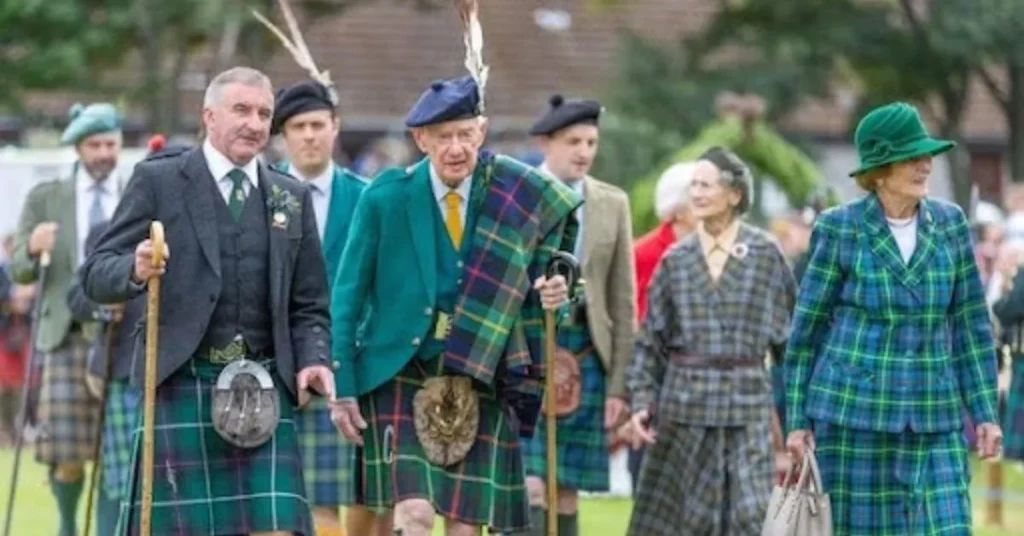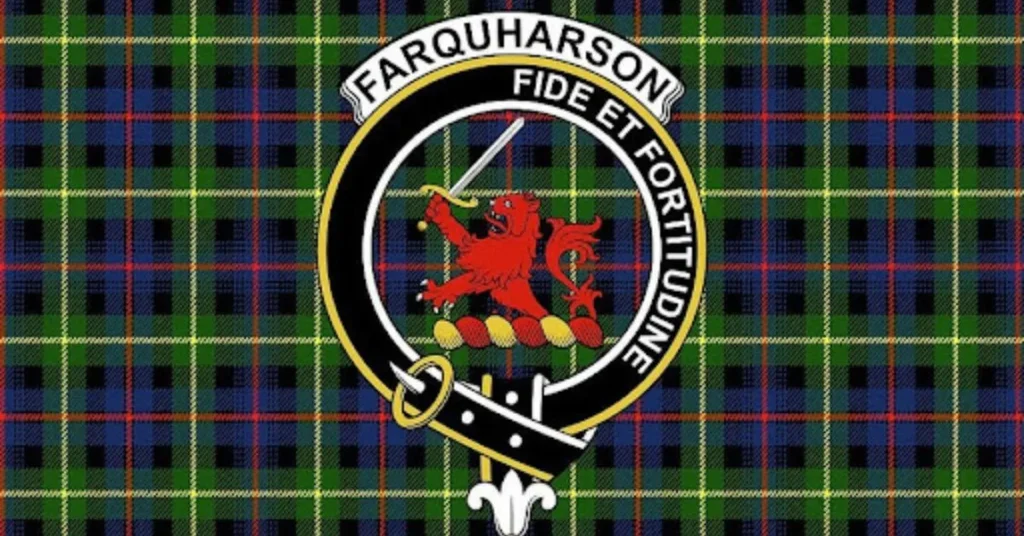Tartans are not mere patterns; they are the threads that weave the tapestry of Scottish history and culture. Each tartan tells a story, and the Farquharson Tartan is no exception. In this article, we embark on an enlightening voyage to uncover the rich history, vibrant colors, and the deep-rooted connection between the Farquharson Tartan and Scotland. We’ll also explore how this iconic tartan is incorporated into clothing, allowing wearers to proudly display their Scottish heritage.
Contents
A Glimpse into the Farquharson Tartan’s Colors
The Farquharson Tartan is a visually captivating pattern characterized by its distinct colors. At first glance, one can’t help but be drawn to its harmonious blend of earthy tones. The dominant background of the Farquharson Tartan is a rich forest green, reminiscent of the lush Scottish landscapes that have inspired generations. This verdant green pays homage to the rolling hills, dense woodlands, and sweeping moors that define Scotland’s natural beauty.
Green has long symbolized growth, renewal, and the enduring spirit of nature. In the context of the Farquharson Tartan, it mirrors the fertile lands and the strong connection between the clan and the Scottish countryside. It’s a color that resonates deeply with the heart and soul of Scotland.
The Farquharson Tartan is often proudly displayed in the form of a traditional Scottish garment known as the kilt. The kilt, a symbol of Scottish heritage and identity, is made from yards of finely woven tartan fabric, meticulously pleated and wrapped around the waist. The Farquharson Tartan, with its striking combination of rich forest green and other earthy tones, lends itself beautifully to the creation of these iconic kilts.
Wearing the Farquharson Tartan kilt is not just a fashion statement; it’s a way for members of the clan to honor their ancestry and roots. As wearers stride confidently, the swaying pleats of the kilt evoke images of the Scottish Highlands, where the Farquharson clan has resided for centuries.
Over the green canvas, bold navy blue and black stripes intersect, creating a visually striking contrast. These dark colors represent strength, resilience, and the indomitable spirit of the Farquharson Clan. They symbolize the determination of a clan that has weathered centuries of challenges and emerged unbroken, a testament to the enduring legacy of Scotland.
The Farquharson Tartan is a harmonious interplay of colors, each with its own significance. The green, navy blue, and black blend seamlessly to create a pattern that reflects the timeless beauty of Scotland’s landscapes and the unwavering spirit of its people.
Unraveling the History of the Farquharson Tartan
To understand the history of the Farquharson Tartan, we must embark on a journey through time, tracing the footsteps of the Farquharson Clan and their enduring legacy in Scotland.
The Origins of the Farquharson Clan
The roots of the Farquharson Clan can be traced back to the 13th century in the rugged and picturesque region of the Scottish Highlands. The clan takes its name from the Gaelic “Fearchar,” meaning “dear one.” Over the centuries, the Farquharsons would come to be known as a resilient and formidable Highland clan.
The Farquharsons – Loyalty and Valor
One of the defining moments in the clan’s history was their unwavering loyalty to the Scottish crown during the Jacobite uprisings. The Farquharsons, under the leadership of their chief, fought bravely for the cause they believed in. Their valor on the battlefield earned them recognition and respect.
Tartan – A Symbol of Clan Identity
Tartans, as symbols of clan identity, began to emerge in the 16th century. They served as a means of identification on the battlefield and a visual representation of a clan’s unique history and traditions. The Farquharson Tartan, with its distinctive colors and pattern, became a proud emblem of the clan’s heritage.
The Farquharson Tartan’s Connection to Scotland
The Farquharson Tartan is more than a piece of fabric; it’s a reflection of Scotland’s natural beauty, resilience, and the enduring spirit of the Farquharson Clan.
Scotland’s Natural Beauty
The deep green of the Farquharson Tartan captures the essence of Scotland’s breathtaking landscapes. Scotland is renowned for its diverse terrain, from the rugged Highlands to the tranquil Lowlands, and from the windswept islands to the serene lochs. The green in the tartan pays homage to the stunning scenery that has captured the hearts of Scots and visitors for generations.
Resilience & Spirit
The dark navy blue and black stripes in the tartan symbolize the resilience and determination of the Farquharson Clan. Scotland’s history is marked by challenges, from battles for independence to political upheaval. The Farquharsons, like the bold stripes in their tartan, stood firm in the face of adversity, embodying the indomitable spirit of the Scottish people.
The Farquharson Tartan represents not only the clan’s pride but also the enduring bond between the clan and the land they call home. It serves as a reminder of the strength and spirit that have defined Scotland throughout its history.
Farquharson Tartan Clothing – A Display of Heritage in 2024

The Farquharson Tartan isn’t confined to the pages of history; it lives on through a wide range of Plaid Clothing, allowing wearers to proudly display their Scottish heritage. Let’s delve into the various ways in which the Farquharson Tartan is incorporated into traditional Scottish attire.
The Kilt – A Symbol of Identity
The most iconic representation of the Farquharson Tartan is the kilt. Kilts are knee-length, pleated skirts traditionally worn by Scottish men. Farquharson Clan members and those with Scottish heritage often choose kilts made from Farquharson Tartan fabric for special occasions and gatherings. The kilt serves as a symbol of identity, a connection to ancestral roots, and a proud display of clan heritage. It’s not just a piece of clothing; it’s a statement of pride in one’s Scottish heritage.
Tartan Skirts – Celebrating Femininity
Women also embrace the Farquharson Tartan with grace and style. Tartan skirts, often in the Farquharson pattern, are a fashionable choice for those looking to celebrate their clan’s heritage. These skirts are versatile and can be worn on various occasions, from casual outings to formal events. They offer women the opportunity to proudly display their Scottish roots while adding an elegant touch to their attire.
Sporrans – A Traditional Accessory
The sporran is an essential part of traditional Scottish attire, often worn with kilts. It is a pouch or purse, typically made of leather or fur, and adorned with decorative elements, including Farquharson Tartan fabric. Sporrans serve both a practical and aesthetic purpose, providing a place to carry small items while adding a touch of tradition to the kilt ensemble. A Farquharson Tartan sporran completes the look with a nod to the clan’s heritage.
Fly Plaids – Adding Elegance
Fly plaids are large pieces of tartan fabric worn over the shoulder and fastened with a brooch. They add an element of elegance and formality to Scottish attire, especially when worn with a jacket and vest. Farquharson Tartan fly plaids are a striking addition to formal Highland dress, making a bold statement at events like weddings, ceilidhs, and other special occasions.
Scarves – A Touch of Tradition
Scarves are a versatile accessory that allows anyone to incorporate the Farquharson Tartan into their attire. Whether worn around the neck or draped over the shoulders, Farquharson Tartan scarves add a touch of tradition to everyday wear. They are not only stylish but also a meaningful way to celebrate Scottish heritage and culture.
Tartan Pants – Modern Interpretation
For those seeking a modern interpretation of Scottish attire, tartan pants in the Farquharson pattern are a popular choice. These trousers offer comfort and style, allowing wearers to embrace their clan’s heritage in a contemporary fashion. Whether worn casually or as part of a semi-formal outfit, Farquharson Tartan pants are a unique way to showcase Scottish pride.
Suits – Formal Elegance
Farquharson Tartan suits are a striking choice for formal occasions. These suits often feature a tailored jacket and matching trousers, both crafted from Farquharson Tartan fabric. They are a statement of sophistication and heritage, making a memorable impression at weddings, galas, or other important events. Farquharson Tartan suits combine modern tailoring with traditional patterns, creating a timeless and distinguished look.
Jackets & Vests | Completing the Ensemble
To complete the Highland dress ensemble, jackets and vests in Farquharson Tartan are commonly worn. The jacket is often tailored and adorned with decorative buttons, while the vest complements the overall look. When combined with a kilt, sporran, and other accessories, a Farquharson Tartan jacket and vest create a cohesive and elegant appearance, making the wearer stand out at formal gatherings and celebrations.
Conclusion – Embracing the Farquharson Tartan’s Legacy
The Farquharson Tartan is more than just a pattern; it’s a symbol of Scotland’s natural beauty, the resilience of the Farquharson Clan, and a proud connection to Scottish heritage. Its distinctive colors and historical significance make it a cherished part of Scotland’s cultural heritage.
As we celebrate the Farquharson Tartan and its deep connection to Scotland, we also pay homage to the broader tradition of tartan patterns, each with its unique story to tell. These patterns serve as a reminder of the enduring spirit and rich heritage of Scotland, a nation that continues to captivate the world with its history, culture, and traditions.
Whether you’re donning a Farquharson Tartan kilt or simply admiring its colors from afar, you’re participating in a centuries-old legacy that celebrates the beauty and resilience of Scotland, a land that has left an indelible mark on the hearts of its people and those who appreciate its unique and enduring heritage.

